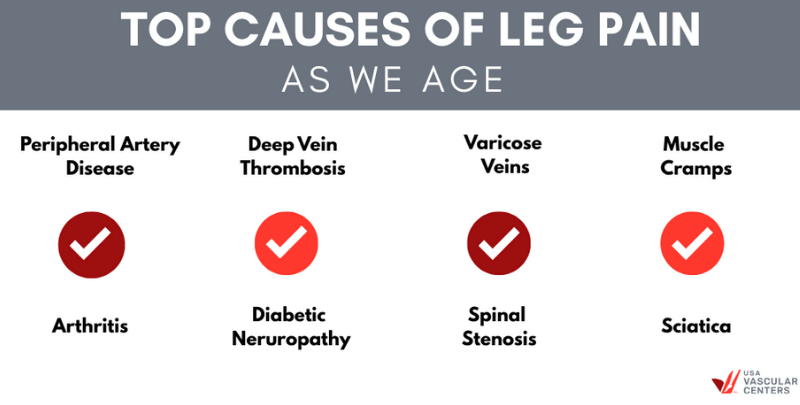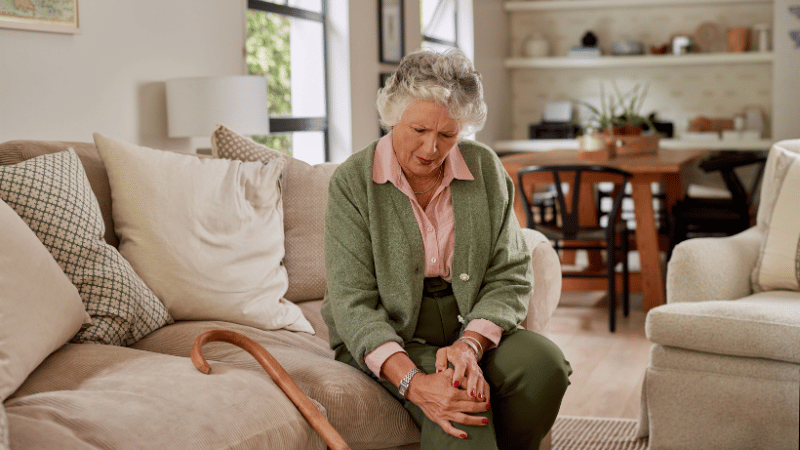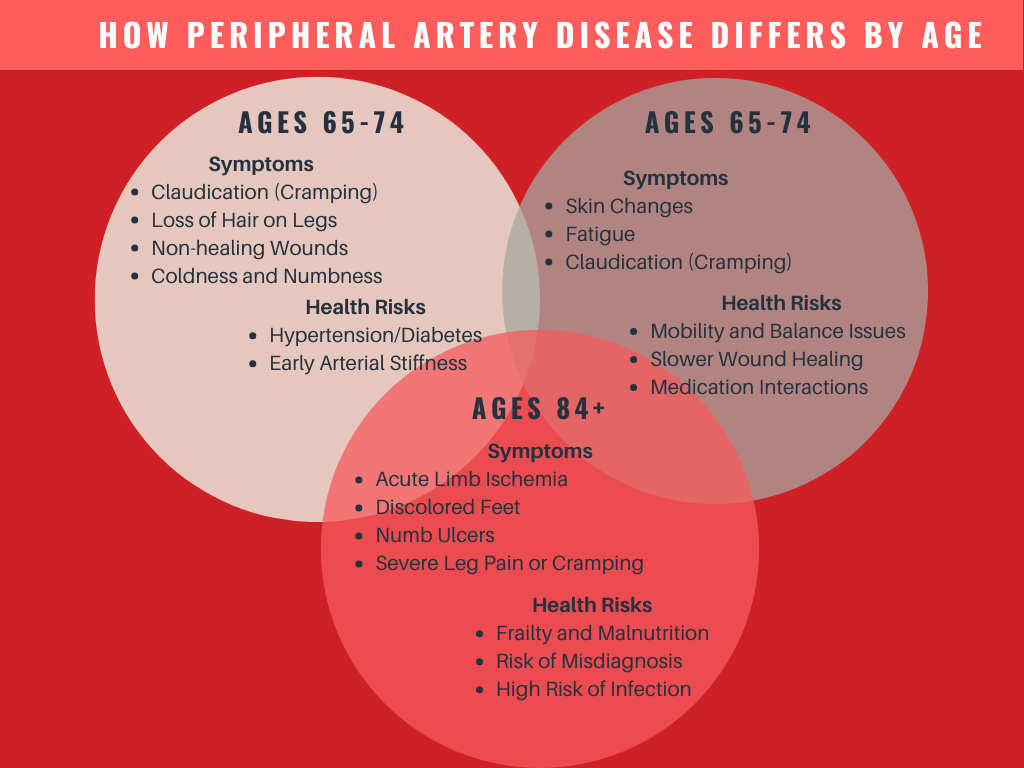Aches, cramps, and leg pain can become more common with age and may interfere with daily activities, including walking or completing routine tasks. For many older patients, the pain may subside when resting, which is why leg pain is often dismissed as a normal part of the aging process.
However, persistent or worsening leg pain can be a symptom of joint issues, mobility problems, or vascular diseases like peripheral artery disease (PAD) that require medical attention.
Discover the common causes of leg pain in the elderly and older adults, recognize the key symptoms to watch out for, and learn how to receive proper treatment.
Leg pain is a common symptom of various medical conditions. Some common causes of leg pain in older age include:
- Arthritis: Conditions like arthritis in the knees or hips can cause cartilage damage, leading to pain and inflammation in the affected areas.
- Nerve-related: Damage can be caused by spinal stenosis, sciatica, or diabetic neuropathy, which can cause sharp, intense pain in the legs.
- Blood Flow Problems: As we age, the arteries naturally start to stiffen, causing reduced circulation to the lower extremities, which can result in varicose veins or peripheral artery disease (PAD).
Reduced mobility can also weaken the muscles, leading to pain and stiffness in the lower extremities. Weakness in the legs due to poor balance can increase the risk of falls, leading to fractures or bone damage. Medications and infections can also play a role in leg pain.
When Leg Pain Is A Warning Sign of PAD
While leg pain is a common concern at any age, persistent or worsening leg pain in individuals over the age of 60 may be a sign of peripheral artery disease (PAD). The prevalence of PAD is much higher in adults 70 years of age and older, with some studies showing that up to 20% of people in this age group may have the condition.
PAD is a serious vascular condition that occurs when plaque builds up in the arteries, causing the arteries to narrow with reduced blood flow to the lower extremities. You should consider consulting with a doctor if your leg pain is paired with any of the following PAD symptoms:
- A pale or bluish tint to the skin.
- Coldness or numbness.
- Wounds or ulcers on the lower extremities that take a long time to heal.
- Cramping (claudication) that worsens with walking but is relieved by rest.
- A tingling sensation that could indicate poor circulation or nerve issues.
If you’re experiencing any of these symptoms, take the next step in understanding your risk with our online PAD risk assessment quiz.
How PAD Differs By Age
PAD symptoms can look different for different age groups. Leg pain is not always a cause for concern with either age group. However, if the pain is consistent and paired with other symptoms, it could be a sign of an underlying health condition like PAD. Here’s how PAD is different in older populations:
Why Older Adults’ Risk Is Higher For PAD
Older adults are at a higher risk of developing peripheral artery disease because of age-related arterial changes. The arteries naturally stiffen with age, increasing the risk of narrowed arteries in seniors. Conditions like high cholesterol and high blood pressure also increase the risk of PAD.
Why Is PAD Often Underdiagnosed In People Over 65?
Because PAD symptoms are often mistaken for normal signs of aging, arthritis, or nerve pain, older adults are at an increased risk for a delayed or missed diagnosis. Many people wait to see a doctor until they have severe symptoms like non-healing wounds or skin discoloration.
To get the care you need, it’s important to tell your doctor about any leg pain or symptoms you’re experiencing. Regular vascular screenings offer ongoing monitoring and help detect PAD early, which can significantly improve treatment outcomes. You can schedule a screening online at USA Vascular Centers and confirm your insurance coverage at the same time.
Schedule A Screening Online Today
Diagnosing PAD As The Cause Of Leg Pain
A vascular specialist should evaluate persistent or worsening leg pain. They can assess symptoms using specialized tests and diagnostic tools, such as ultrasounds or angiography, to identify blockages in the arteries. They’ll also review your medical history to identify any patterns and help identify what may be causing your leg pain.
PAD Treatment Options For Aching Legs
PAD is a progressive disease. Without treatment, it can worsen, limiting your mobility and increasing the risk of severe complications. Fortunately, with an early diagnosis, the disease can be managed effectively.
Minimally Invasive Treatments
At USA Vascular Centers, we offer three minimally invasive, non-surgical PAD treatments that are well-tolerated and provide a fast recovery. These outpatient procedures aim to restore blood flow and stop the disease from progressing:
- Angioplasty: A tiny balloon is used to open blocked arteries.
- Stent Placement: A mesh tube (stent) is inserted to keep the artery open.
- Atherectomy: Plaque is removed from the artery using a specialized catheter.
Your vascular specialist may also recommend lifestyle changes and medication to support your treatment.
The Risks of Not Getting Treated
If PAD is left untreated, the disease can become life-threatening. The plaque buildup that causes PAD can lead to:
- Worsening leg pain
- Increased risk of heart attack and stroke
- Limb-threatening complications, including the need for amputation in severe cases.
Next Steps for Older Adults With Leg Pain And PAD Risk
Leg pain should not automatically be attributed to aging, especially when it is persistent or worsening. While aches and pains are more common as you get older, chronic pain can also be a sign of a more serious vascular issue like peripheral artery disease.
USA Vascular Centers provides non-surgical, outpatient care for seniors with PAD. We have nationwide clinics and a team of vascular specialists ready to provide you with a tailored treatment plan that aligns with your specific needs. From the consultation to the diagnosis, our team will be there to guide you through the treatment process every step of the way.
Call Now To Book Your Consultation
FAQs About Leg Pain in Older Adults
What are the risks of ignoring leg pain in people over age 65?
By the time PAD is diagnosed in older adults, they may already be experiencing more severe symptoms like rest pain (pain in the feet or toes that occurs while resting) or non-healing wounds. These are signs of a critical lack of blood flow, which significantly increases the risk of limb loss or other serious cardiovascular events.
Can PAD progress more quickly in older adults?
Peripheral artery disease (PAD) can progress quickly in seniors due to the arteries naturally stiffening with age, causing them to narrow. Older Adults are also more likely to have diabetes, high cholesterol, or high blood pressure, which are common risk factors for PAD.
Is it safe for older patients to undergo PAD procedures?
Minimally invasive PAD treatments are generally well-tolerated and carry a lower risk of complications compared to traditional open surgery. Your vascular specialist will thoroughly evaluate your overall health to develop a customized and cautious treatment plan that is the safest for you, regardless of your age.





